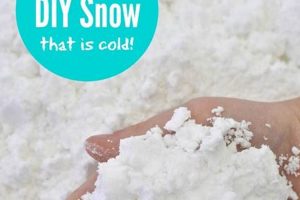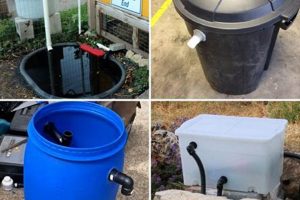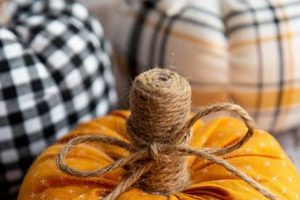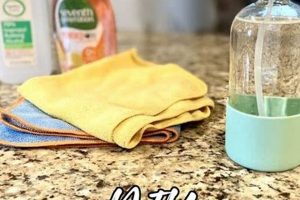Reusable food coverings created at home with beeswax, fabric, and sometimes other ingredients such as tree resin and jojoba oil, provide an alternative to disposable plastic wraps. These coverings conform to the shape of containers and foods through the warmth of one’s hands, creating a seal that helps preserve freshness. As an example, a homemade beeswax-coated cloth can be used to cover a bowl of leftovers or to wrap a sandwich for transport.
The use of these sustainable alternatives reduces reliance on single-use plastics, thus minimizing environmental impact. They are compostable at the end of their lifespan, further contributing to waste reduction. Historically, waxed fabrics have been used for centuries for various purposes, including waterproofing and food preservation, showcasing a return to traditional, eco-conscious practices.
The following sections will detail the materials required, step-by-step instructions for creation, proper cleaning and maintenance techniques, and suggestions for customizing these environmentally-friendly food storage solutions.
Tips for Crafting Quality Food Coverings
Achieving optimal performance and longevity requires careful attention to detail throughout the process. The following guidance enhances the overall quality and usability of the finished product.
Tip 1: Select Appropriate Fabric: Opt for tightly woven, natural fabrics such as cotton or linen. These materials provide a stable base for the beeswax coating and resist fraying during use.
Tip 2: Ensure Proper Wax Distribution: Evenly distribute the melted beeswax mixture across the fabric surface. Uneven distribution can lead to cracking or inadequate adhesion, compromising the covering’s effectiveness.
Tip 3: Pre-Wash the Fabric: Washing the fabric before applying the beeswax removes any sizing or finishes that may interfere with the bonding process, resulting in better adhesion and a longer-lasting product.
Tip 4: Use Food-Grade Beeswax: Always select food-grade beeswax to ensure safety when in contact with food. Industrial-grade beeswax may contain impurities or additives that are unsuitable for food storage.
Tip 5: Control Heat Exposure: When melting the beeswax, maintain a low and consistent heat. Overheating can degrade the beeswax, affecting its texture and adhesive properties.
Tip 6: Allow Proper Cooling Time: Allow the finished wraps to cool completely before using them. This ensures that the beeswax sets properly and creates a firm, pliable seal.
Tip 7: Consider Adding Tree Resin: Incorporating a small amount of tree resin enhances the stickiness and adhesive properties of the beeswax mixture. This addition is particularly beneficial for creating a stronger seal around containers.
By adhering to these guidelines, individuals can create durable, effective, and safe food coverings that promote sustainability and reduce reliance on disposable alternatives.
The next section will provide information on cleaning, maintaining, and properly disposing of these sustainable food storage items.
1. Material Selection
The selection of materials is a foundational element in the creation of effective and sustainable reusable food coverings. The type of fabric and the quality of the wax directly influence the performance, longevity, and safety of the finished product. Careful consideration must be given to these elements to ensure a functional and environmentally responsible outcome.
- Fabric Type
The fabric serves as the base for the beeswax coating. Tightly woven natural fibers, such as cotton or linen, are preferred due to their durability and ability to absorb the wax evenly. Loosely woven fabrics may result in an uneven coating and reduced lifespan. Synthetic fabrics are generally avoided, as they do not bond effectively with beeswax and may release undesirable chemicals when heated. The choice of fabric directly impacts the wrap’s flexibility, adhesion, and washability.
- Beeswax Quality
The quality of the beeswax is paramount for both performance and safety. Food-grade beeswax, free from additives and impurities, is essential for contact with food. Industrial-grade beeswax may contain contaminants that could leach into food items. Furthermore, the refining process of beeswax can affect its pliability and scent. Using high-quality beeswax contributes to a more effective seal and a longer-lasting wrap.
- Additional Ingredients
Some recipes incorporate additional ingredients such as tree resin (rosin) and jojoba oil. Tree resin enhances the stickiness and adhesive properties of the wrap, creating a stronger seal around containers. Jojoba oil adds flexibility and prevents the beeswax from becoming brittle. The inclusion of these ingredients, and their respective qualities, can significantly impact the wrap’s performance and durability. Their selection should be carefully considered based on desired properties and food safety.
- Dye and Print Considerations
When using patterned or dyed fabrics, it is crucial to ensure that the dyes are non-toxic and food-safe. Certain dyes may leach chemicals when heated or in contact with food, potentially posing a health risk. Natural dyes are generally preferred over synthetic dyes for this application. Additionally, the print or pattern may affect the beeswax’s ability to adhere properly to the fabric, particularly if the print is raised or textured.
In conclusion, the careful selection of fabric, beeswax, and any additional ingredients is crucial for creating effective, safe, and durable reusable food coverings. The properties of these materials directly impact the wrap’s ability to adhere, protect food, and withstand repeated use and cleaning, ultimately determining its value as a sustainable alternative to plastic wraps.
2. Wax Application
The uniform distribution of wax onto fabric is fundamental to the functionality and effectiveness of homemade, reusable food coverings. The method and quality of wax application directly impact the wrap’s ability to adhere to surfaces, protect food, and withstand repeated use and cleaning.
- Melting Point and Temperature Control
Achieving the correct wax temperature is critical for proper saturation of the fabric. If the wax is not heated sufficiently, it will not penetrate the fibers effectively, resulting in poor adhesion and a brittle finished product. Overheating the wax can degrade its properties and potentially pose a fire hazard. A double boiler or a low-heat setting on a stovetop are recommended to maintain a consistent and safe melting temperature. The optimal temperature ensures an even distribution of the wax throughout the fabric, leading to a pliable and durable wrap.
- Application Methods
Various methods
can be employed to apply the wax mixture to the fabric. Brushing, pouring, and grating the wax directly onto the fabric followed by baking are common techniques. Each method offers distinct advantages and disadvantages. Brushing allows for precise control over the amount of wax applied, while grating and baking ensures even distribution through heat. The chosen method should facilitate a consistent and uniform coating across the entire surface of the fabric to maximize adhesion and prevent bare spots. - Wax Mixture Composition
The composition of the wax mixture significantly influences the application process and the final product’s characteristics. Adding ingredients such as tree resin increases the stickiness of the wrap, while jojoba oil enhances its flexibility. These additives must be thoroughly mixed with the molten beeswax to ensure a homogeneous blend. An inconsistent mixture can result in uneven adhesion and variations in the wrap’s pliability. Careful attention to the proportions and blending process is essential for achieving a consistent and functional coating.
- Coverage and Saturation
Adequate coverage and saturation of the fabric are paramount for creating a protective and durable food covering. The wax must completely permeate the fabric fibers, creating a barrier against air and moisture. Insufficient coverage can lead to premature wear and reduced effectiveness in preserving food. Conversely, excessive wax application can result in a stiff and inflexible wrap that is difficult to mold. The goal is to achieve a balance between thorough saturation and pliability, ensuring the wrap effectively seals and conforms to various shapes and sizes.
In summary, careful attention to melting point, application method, mixture composition, and coverage are critical for effective wax application in the construction of homemade, reusable food coverings. These elements collectively determine the wrap’s ability to adhere, protect food, and withstand repeated use, underscoring the importance of mastering these techniques for a sustainable and functional alternative to plastic wraps.
3. Adhesion Quality
Adhesion quality is a critical performance characteristic of homemade, reusable food coverings and directly determines their practical utility. The ability of a beeswax-coated fabric to adhere effectively to itself and to various container surfaces is essential for creating a secure seal that preserves food and prevents spoilage. Poor adhesion compromises the wrap’s functionality, rendering it ineffective as a food storage solution. The success of this alternative hinges on the wrap’s ability to form a tight, protective barrier.
Several factors influence the adhesion quality of these wraps. The type and ratio of ingredients in the wax mixture, the method of application, and the characteristics of the fabric all play significant roles. For instance, a mixture lacking sufficient tree resin may exhibit inadequate stickiness, leading to difficulty in sealing. Similarly, uneven wax distribution or the use of a fabric with a loose weave can result in inconsistent adhesion across the wrap’s surface. Consider the example of a wrap used to cover a bowl of cut fruit. If the wrap does not adhere properly to the bowl’s rim, air will enter, causing the fruit to brown and spoil more quickly. The quality of the seal is paramount in maintaining freshness.
Optimal adhesion quality is achieved through meticulous attention to detail in the crafting process. Proper fabric preparation, precise control of wax temperature, and the inclusion of appropriate additives are all crucial steps. The efficacy of these wraps as a sustainable alternative to disposable plastic films depends on consistently achieving a reliable and durable seal. While challenges may arise from variations in material quality or user technique, a thorough understanding of the factors influencing adhesion is essential for maximizing the performance and longevity of homemade food coverings. Therefore, prioritizing adhesion quality leads to a more effective and environmentally responsible food storage solution.
4. Wrap Lifespan
The longevity of reusable food coverings represents a critical factor in assessing their sustainability and economic viability as alternatives to disposable plastic wraps. The lifespan of these coverings directly influences their environmental impact and the frequency with which they need to be replaced, impacting overall resource consumption.
- Material Degradation
The beeswax coating undergoes gradual degradation with repeated use and cleaning. Washing, particularly with hot water or harsh detergents, can strip away the wax and reduce its adhesive properties. The fabric base may also weaken over time due to repeated stretching and exposure to moisture. An example is the gradual reduction in stickiness observed after multiple washes, leading to a less effective seal. This degradation limits the period for which the wrap can effectively function.
- Maintenance Practices
Proper care and maintenance practices can significantly extend the life of these food coverings. Gentle washing with cool water and mild soap helps preserve the wax coating. Avoiding direct heat and storing the wraps properly when not in use minimizes physical damage. Regular refreshing of the wax coating, using a low-heat iron, can restore adhesion and extend the wrap’s usability. Neglecting these practices accelerates the degradation process.
- Frequency of Use
The frequency with which the wrap is used directly impacts its lifespan. A wrap used daily will degrade more quickly than one used only occasionally. The type of food stored also plays a role. Acidic foods, for instance, can accelerate the breakdown of the wax coating. Consequently, heavy usage necessitates more frequent maintenance and eventual replacement.
- Material Quality
The initial quality of the materials used in the construction greatly influences the lifespan of the product. High-quality, tightly woven fabrics and food-grade beeswax tend to be more durable and resistant to degradation. Lower-quality materials may break down more quickly, shortening the wrap’s overall lifespan. Therefore, investing in higher-quality materials typically translates to a longer-lasting and more cost-effective product.
In conclusion, the usable life of these alternative food storage options is contingent on a combination of factors encompassing material quality, maintenance practices, and usage patterns. While these coverings offer a sustainable alternative to single-use plastics, maximizing their longevity through proper care and material selection is essential to realizing their full environmental and economic benefits. Attention to these details ensures these coverings remain a viable and responsible choice for food storage.
5. Sanitization Practices
The integrity of homemade beeswax food coverings as a sustainable alternative hinges directly on the efficacy of implemented sanitization practices. These practices determine the safety and suitability of the wraps for repeated contact with food. Inadequate cleanin
g protocols can lead to the accumulation of bacteria and other pathogens, negating the intended benefits of reducing plastic waste. Effective sanitization is not merely a supplementary step but an integral component of creating a safe and reusable food storage solution.
The primary cause of bacterial contamination stems from residual food particles and moisture trapped within the fabric or beeswax. For instance, if a wrap used to cover a cut avocado is not properly cleaned, the remaining avocado residue can harbor microorganisms that proliferate over time. This contamination presents a potential health risk, especially if the wrap is subsequently used to store other types of food. A practical example is the recommended practice of washing the wraps with cool water and mild soap immediately after each use. This removes food debris and prevents bacterial growth. Regular inspection for signs of mold or persistent odors is also crucial, indicating the need for more rigorous cleaning or disposal.
Challenges in maintaining proper sanitization arise from the inherent properties of beeswax and fabric. Beeswax is susceptible to melting or degradation at high temperatures, limiting the use of heat-based sanitization methods. Furthermore, the porous nature of fabric can make it difficult to completely remove embedded food particles. Despite these challenges, consistent adherence to recommended cleaning protocols, including gentle washing and thorough drying, can effectively minimize the risk of contamination and extend the usable lifespan of the wraps. Prioritizing sanitization practices is essential for ensuring that reusable food coverings remain a safe and sustainable alternative to single-use plastics.
Frequently Asked Questions
The following addresses common inquiries regarding the creation, usage, and maintenance of reusable, beeswax-coated fabric for food storage.
Question 1: What fabric types are most suitable for creating these coverings?
Tightly woven, natural fabrics such as organic cotton or linen are recommended. These materials provide a stable base for the beeswax coating and minimize the risk of fraying. Synthetic fabrics are generally not suitable due to their poor absorption and potential for melting at high temperatures.
Question 2: What type of beeswax should be used?
Food-grade beeswax, free from additives and impurities, is essential. Industrial-grade beeswax may contain substances harmful to human health. The use of cosmetic-grade beeswax is also acceptable, provided it is explicitly labeled as safe for contact with food.
Question 3: How are these food coverings properly cleaned?
Washing by hand with cool water and a mild, eco-friendly dish soap is recommended. Hot water can melt the beeswax coating, reducing its effectiveness. Harsh chemicals and abrasive scrubbers should be avoided to prevent damage to the fabric and wax.
Question 4: What is the expected lifespan of a homemade food covering?
The lifespan varies depending on usage frequency and maintenance. With proper care, a single covering can last for several months to a year. Signs of degradation, such as cracking or separation of the wax, indicate the need for replacement.
Question 5: What types of food are not suitable for storage using these coverings?
Raw meat and poultry should not be directly wrapped in beeswax coverings due to the potential for bacterial contamination. These coverings are best suited for storing fruits, vegetables, bread, cheese, and leftovers.
Question 6: How is the adhesive quality of the coverings maintained?
If the covering loses its stickiness, it can be refreshed by placing it on a baking sheet lined with parchment paper and heating it in a low-temperature oven (approximately 200F or 93C) for a few minutes. This will remelt the beeswax and redistribute it, restoring the adhesive properties.
In summary, effective creation, usage, and maintenance of beeswax food coverings rely on careful material selection, proper cleaning techniques, and an understanding of their limitations.
The subsequent section will explore advanced customization options for these sustainable food storage solutions.
DIY Beeswax Wrap
The preceding exposition has detailed the multifaceted nature of diy beeswax wrap, encompassing material selection, application techniques, adherence qualities, lifespan considerations, and essential sanitization protocols. Emphasis has been placed on the meticulous approach required to produce effective, sustainable alternatives to conventional plastic films. Furthermore, the provided FAQs have addressed common concerns, ensuring comprehension of best practices for creation and maintenance.
The adoption of diy beeswax wrap represents a conscious step toward minimizing environmental impact through reduced plastic consumption. Its effectiveness, however, hinges on diligent adherence to established guidelines and a commitment to proper hygiene. Continued research and refinement of techniques will further enhance its utility and solidify its position as a viable, eco-responsible solution for food storage.







